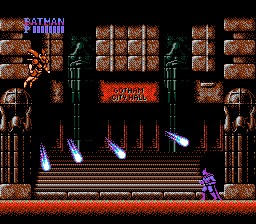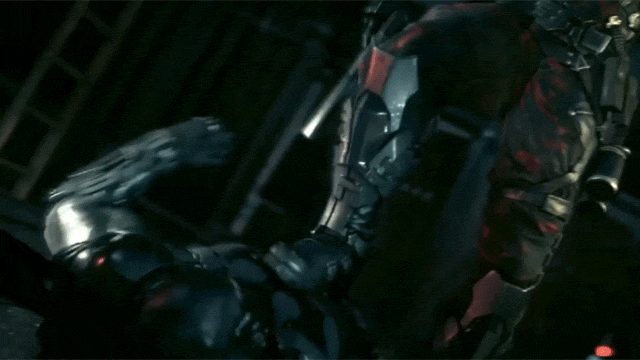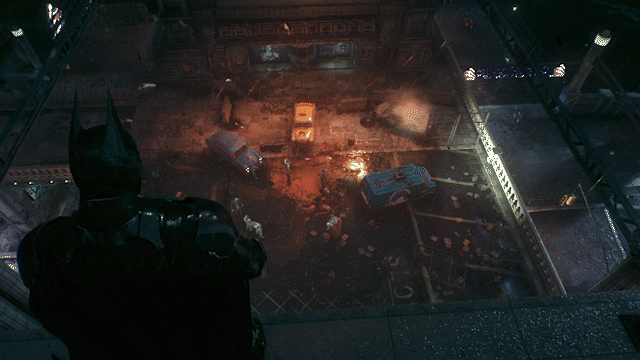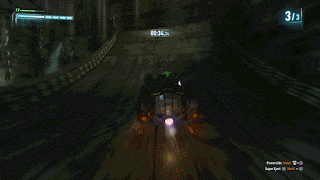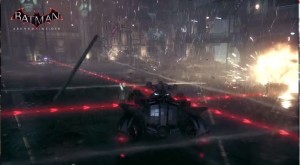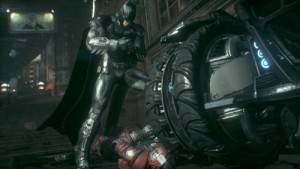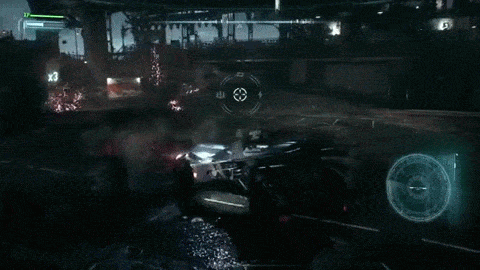I’ve been mostly a Marvel guy for the majority of my life. There’s always been something about franchises like “X-Men” that I gravitated towards more than any other comic series. But, ironically enough, my first experience with a video game based on a superhero (or heroes) didn’t involve anything Marvel. Instead, my first superhero video game was “Batman” for the Nintendo Entertainment System. Though the game wasn’t released long after the first “Batman” movie not featuring more trippy moments that you could shake a hippie at, I didn’t own or play the game until a year after its gracing store shelves. And I was terrible.
Though I enjoyed most of what I could with “Batman” (being a young gamer with a short attention span when it came to hard games), I never got into the sequels, both canonical and spiritual. And reviewers seemingly agreed that future “Batman” games just weren’t worth the time. Then something changed. Almost two decades after I played “Batman” on the NES, Rocksteady Studios developed the first in what would become a series of games featuring “The Dark Knight” to great success. Both critics and consumers alike praised the first iteration, “Batman: Arkham Asylum”. I was apprehensive, but eventually gave in and purchased the game shortly before the sequel was released. And, for the first time since I was five, I was enjoying a Batman game.
“Batman: Arkham City” was the next game from Rocksteady and too was given high praise thanks to its retaining of “Asylum’s” strong combat system while opening up the world of Arkham City for gamers to interact with more than just The Joker. The franchise stumbled a bit with “Batman: Arkham Origins” (mostly thanks to a weak story and a lack of innovation), but promised to deliver the finale of the lifetime with the Playstation 4/Xbox One-exclusive “Batman: Arkham Knight”. Of course I was geared up for what many believed would be a candidate for the 2015 “Game of the Year”.
Did I Complete “Batman: Arkham Knight”
For the first time in the “Arkham” series of games, “Arkham Knight” (or “AK”) is set in “modern day” Gotham City where Batman has grown more fatigued with the constant battles caused by villains attempting (and, at times succeeding) to ruin not only Gotham, but the man behind the mask himself. Thankfully for players of previous “Arkham” games, “AK” feels like familiar territory. Not much has changed when it comes to the mostly perfect combat system that has actually been copied by other games in the genre (“Shadow of Mordor” for example).
The story focuses on two major adversaries looking to take down Batman one final time, Scarecrow and the man behind the game’s title, The Arkham Knight. Scarecrow’s penchant for causing fear through a toxin he continuously promises to release throughout Gotham (though it really doesn’t matter too much as most of the people in Gotham are evacuated when Scarecrow unveils his plan – leaving nothing by hoodlums and thugs for Batman to wade through) at times plays second fiddle to The Knight’s audible posing and declarations of death to the man he claims to know better than anyone.
As the player progresses through the story, he/she gets to experience the abilities of The Arkham Knight firsthand while Scarecrow – the heavily promoted villain in this game – seems like nothing more than window dressing for a couple of plot twists; though Scarecrow is integral to the game’s conclusion. The story keeps plugging along, sprinkling in reminders that side quests are available because, lo and behold, 100% completion of the game is necessary to see the full ending. That’s right, play through the game’s story, but don’t expect to see how “AK” really concludes unless you’ve locked up all of the major villains moving throughout Gotham.
This wouldn’t be so bad if one of those requirements for 100% didn’t include collecting the 200-plus Riddler trophies scattered throughout the city (with some being unattainable without solving puzzles that range from easy as cake to demented as a grappling hook to the groin). While I completed the story and almost all of the side quests (including the Riddler’s races and battles to free Catwoman), I just couldn’t put myself through the boredom of collecting all of the Riddler trophies. I’m perfectly content about watching the full ending on Youtube (and there’s a good chance you’ll be too).
Did “Batman: Arkham Knight” Live Up to the Hype?
If “Arkham Asylum” was being called the first “definitive Batman game”, then “Arkham Knight” promised to be the culmination of everything started in “Asylum”, expanded in “Arkham City” and innovative unlike “Arkham Origins”. While, as mentioned above, the combat system – still featuring basic “light”, “strong” and “counter” attacks – feels mostly the same as the previous “Arkham” games, there are a few additions to one of the best things about the series. First there are the “Fear Takedowns”. By using silent takedowns during missions, Batman builds up his “Fear Meter” that gives the hero an opportunity to swoop down or up for clean knockouts on (up to five) unsuspecting enemies. In certain situations, Batman will have the opportunity to team up with another character in combat. These battles result in each character fighting a group of bad guys while building up another meter that allows for a double team attack that not only knocks out an opponent, but also switches the player’s character; giving said gamer the chance to experience the “Free Flow Combat” experience as someone other than Batman.
The enemy A.I. can be flaky at times, but more often than not even minor adversaries are alert and ready to pick Batman apart (especially if they’re armed with guns) or able to revive fallen comrades if a “Medic” is in the pack. If enemies have a direct line to The Knight, they listen to his advice and follow it to a “T”; forcing the player to adjust his/her strategy at a moment’s notice – taking away that “lie & wait” problem seen during previous “Arkham” games. Batman’s ability to see through walls and nearby enemies with “Detective Mode” has also been altered in a good way. A third of the way into the game, enemies acquire devices that can either scramble Batman’s vision or make Batman a living homing beacon when using Detective Vision/Mode. Once again, the much-needed change takes away a reliance on something that made the previous games much easier than the needed to be.
But not everything is about taking away to make the game better. Actually, you can take the advantages enemies have with upgraded gadgets like the “Disruptor” gun that can turn a villain’s gun into a grenade when fired by its user. If Batman is stuck in the middle of a losing firefight, he can toss a smoke bomb to the ground and flee without complication. The hacking device also plays a big role in combat as sentry guns, drones and the like become tools of help for Batman rather than destruction. Though previous “Arkham” games gave players the ability to utilize Batman’s various gadgets and weapons, never before has a “Batman” game felt like it was reaching the true depths of what mechanical wizardry the lead character possessed.
The game’s technical wizardry cannot be denied. Few games of this generation look as wonderful and capture the atmosphere of a fictional city better than “AK”. Gotham beams under the figurative oppressive rain the gladly reflects the shimmying neon lighting of buildings just waiting to fall by the wayside. The game’s scope and draw distance is absolutely impressive and usually if you see it, you can reach it (though there are some invisible walls on the far ends of the map). Scattered throughout Gotham are a little over a dozen types of side quests (not counting the Riddler trophies) that can see Batman doing everything from saving hostage firefighters to chasing down patrol cars to even solving a murder mystery. As the player progresses through the story, the side quests open up to give people a chance to not rush through the main plot.
But no addition to this game compares to “AK’s” piece de resistance, the Batmobile. Heavily promoted as the first Batman game to give the player the chance to actually cruise through Gotham in the tank-like vehicle, the Batmobile became more of a poster icon for “Arkham Knight” more than Batman himself. But the Batmobile proves to be more than just a smooth handling vehicle that allows the player to get across the map without gliding with the greatest of ease (gliding in this game is incredibly fun, mind you). With the tap (and/or holding) of a button, the Batmobile turns into the proverbial “Bat-tank” featuring a variety of upgradeable weapons including the Vulcan chain gun and an ability to take over attacking drones so they can team up with your defending machine. The Batmobile also plays a vital role in completing several side quests ranging from disarming bombs to racing through underground tracks somehow constructed by The Riddler.
But Rocksteady’s need to emphasize Batman’s latest toy in the “Arkham” universe comes at a price; specifically regarding story missions. Throughout the game, Batman isn’t forced to just sneak around and solve puzzles like in previous games. Instead, the game is littered with missions that demand the player utilize the Batmobile or not progress. For example – early in the game, Batman has to infiltrate a chemical plant. What appears to be a simple stealth mission becomes a exercise in tedium as Batman has to not only find a way into the plant, he has to also get the Batmobile inside the facility so he can lift a single elevator or blast down a wall that is purposely made as a barrier only the Batmobile can destroy. The problem gets worse and extends missions to the point of tedium rather than leaving me intrigued and not wondering when the next save point is so I could just stop.
Then there are the drone battles featuring the Batmobile. In the previously mentioned chemical plant, Batman contends with a host of rocket launching drones helped by The Arkham Knight and a flying helicopter. The first encounter feels epic and unique. But then the drones keep coming. The bomb disarming side quest is structured around drone battles. And throughout the story, the Batmobile must destroy drivable enemy after enemy without much variety or challenge when each battle is a simple exercise of strafing left or right to get out of the line of fire before obliterating the high-tech piece of weaponry.
The unnecessary reliance on the Batmobile in story missions isn’t the only problem with the plot. Actually, the plot itself is a true tour de force of clichés, predictable outcomes and a sheer lack of urgency that shouldn’t in any way be tied to the finale of a series. There is one plot twist early in the game that affects the Batman character during the story’s remainder, but the “unwelcomed” addition only helps to remind the player just how shallow and uninteresting the main villains of this game are. The revelations and conclusions are also lackluster (and that’s not reiterating the requirements needed to see the full ending).
Thanks to terrible attempts at foreshadowing and a reliance on playing to the source material, situations like the inevitable unmasking of The Arkham Knight are predictable at best, and disappointing at worst. The finale is made even more intolerable by the pure and simple fact there is no final boss battle! So for those hoping to have an experience similar or greater than the Scarecrow level in “Arkham Asylum” to close this chapter, there is no justice. Nope – just enjoy the many tank battles and Rocksteady’s attempt at making The Arkham Knight into this game’s version of “The End” from “Metal Gear Solid 3”. Also, Batman can be a complete jerk and do things that made me want someone like Azreal punch him in his masked face.
It’s quite sad to see the “Arkham” series’ story figuratively stumble across the finish instead of barreling through like the Batmobile through so much toxic gas.
Should You Play “Batman: Arkham Knight”?
When “Batman: Arkham Knight” takes advantage of the incredible foundation set by prior “Arkham” iterations, it’s a wonderful experience that feels like a true fan’s dream “Batman” game come true. The combat is as refined as ever. Gadgets are useful and give you a plethora of options by the game’s final third. But the game’s greatness doesn’t come without its share of problems. The plot is rather disappointing and fails to end the series with a true bang (pun intended). The usage of the Batmobile is a mixed bag of fun racing and interesting early battles before deteriorating into unnecessary puzzles and the feeling of “seen that-done that” when taking on the fifteenth drone battle. From a gameplay perspective, “Arkham Knight” is mostly incredible. But some of the things that could’ve turned this game into an epic finale – the Batmobile, strong villains, a story worth remembering – never panned out and left me wanting something more. I appreciate what Rocksteady provided and believe it should be played eventually. It is a very good game, but not a fantastic, revolutionary experience that it was marketed as and really should’ve been.


